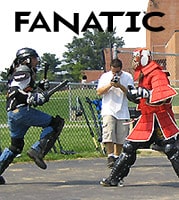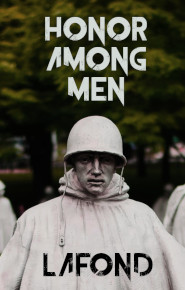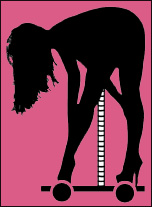A few months ago I decided to rewrite my first book. However, when I got into it I found that it did not categorize according to the scheme adopted for this site. Portions of it will be rewritten into this page and other parts into Harm City titles. What you find below is the beginning of the process, and might be of some interest to those who missed the original release or are wondering about writing their own first self-help book.
The Fighting Edge
Utilizing Your Martial Arts to Fight Better
Second Edition with Author’s Notes
James’ first book was written specifically as a self-help guide for young men interested in developing real combat ability who, due to financial means or location, may not have the ability to access a state-of-the-art reality combat school. If you are just getting by and caught between the strip-mall karate school and ghetto boxing gym, this book was written for you.
The Fighting Edge
Using Your Martial Arts to Fight Better
Second Edition with Author’s Notes
Copyright 2012 James LaFond
Originally published in 2000 by Paladin Press
To my coaches, teammates, training partners, students and antagonists. You have all taught me, knowingly or not, regardless of how willing I was to learn.
Author’s Note to Title
The title of this book was determined by Jon Ford at Paladin Press. My working title, Utilizing the Martial Arts, was rewritten and demoted to subtitle. Very often, if you want to know what the author’s working title was, just look at the subtitle. When I thanked Jon for coming up with a better title and then promised to supply better titles in the future, he responded, “Don’t worry about it. Titles are too important to leave up to a writer.”
Table of Contents
Introduction
Chapter 1: Reality
Chapter 2: Motivation
Chapter 3: Understanding the Martial Arts
Chapter 4: Personal Risks
Chapter 5: Starting Out
Chapter 6: The Fighter’s Body
Chapter 7: The Fighter’s Mind
Chapter 8: Real-Fighting Ability
Chapter 9: Mobility
Chapter 10: Durability
Chapter 11: Defense
Chapter 12: Offense
Chapter 13: Training Forms, Ranges and Drills
Chapter 14: Training Partners and Equipment
Chapter 15: The Untrained Fighter
Chapter 16: Outnumbered!
Chapter 17: Unarmed?
Chapter 18: Survival
Conclusion
Appendix 1: Training Survey
Appendix 2: Fighter Survey
Appendix 3: Violence Survey
Appendix 4: Martial Art Survey
Bibliography
Author’s Note to Table of Contents
Upon deciding to write my first non-fiction book in the self-defense self-help category I knew going in that I faced a huge credibility challenge. I had been reading magazines devoted to this subject for decades. In order to find out what I was really up against I ordered a number of books in this category from Paladin Press, Loompanics Unlimited and Desert Publications. This book survey bolstered my suspicions based on my magazine reading and left me thinking I had little chance of getting published. The reason being that the author ‘pedigrees’ were all based on one or more of the four relatively invulnerable backgrounds:
1. Martial arts master
2. Combat athlete champion
3. Bouncer, law-officer, military veteran or similar socially-sanctioned badass
4. ‘Former’ criminal badass
I was none of these. Indeed, I thought, if I were one of these types of people, why would
I even seek self-defense knowledge?
Thinking that I had a fresh perspective, and wanting to get my first book published I decided to play to my strengths: that I was a self-defense ‘fish’ [like the readers] not a ‘shark’ like the other writers; and that I had significant experience writing and researching other subjects. These facts gave me my mission; to write a well-researched and readable account of self-defense from a vulnerable perspective. This table of contents reflected that ambition and served as a reminder of my mission as I got into the project
I began writing and researching the book in January of 1996 and took 18 months to complete. In the end Paladin picked it up and I alienated a tight-knit group of their self-defense writers, and a minor smear campaign was even launched against me by devotees of the premier pioneer in the field. Once again, I was just another fish in a sea full of sharks. It seemed fitting.
Acknowledgements
Thanks to the following people:
Ted and Betty, for this nifty body, that still works when you give it a good whack.
‘Reds’ Foley, for not letting me fight that middleweight in Charleroi.
‘Irish’ Johnny Coiley, for teaching me how not to eat leather.
Cindy, for this word processor.
Doreen Rockel, CMT, for teaching me how to walk again.
Ralph Gervasio, Jr., for being a great writing coach.
Joseph Estwanik, MD., for answering my medical questions.
Paul Behrendt, for planting this big idea in my small* fertile brain.
Steve Sechi, for convincing me to try nonfiction.
Rick Sensky, for his encouragement and assistance.
Master Joe Nawrozki, for providing valuable insights and commentary.
*This self-deprecating word was purged from the manuscript by my editor. I have restored it. Although I have earned a reputation as a smart if obscure literary figure, I remain, in my mind’s eye, a bemused little monkey scratching his defoliated scalp as he wonders about the unfathomable mysteries of the world in which he manages to eke out a precarious living.
Introduction
Paul, a fit, educated young man
Author’s Note to the Introduction
I have not read this book in ten years. I am not rewriting it. I will restore things cut by the publisher, which will be noted with an asterisk. I will correct typos. If I see something that is really terrible, that I don’t want my name on, I will spare you by deleting it while coming clean by noting the particular atrocity that I purged. The manuscript to this book is long lost, and there was never a usable softcopy, as I wrote it on a proprietary word-processing program. I am reading from my author’s copy of the 2000 Paladin Press release as I retype it and make these commentaries, honestly not knowing what is on the next page. The next page is the single exception, because, according to my editor, it is what sold the book. And, well, one who beseeches editors takes note of such declarations.
A Note on Getting Published
Once you have been lucky enough to have an editor actually read your manuscript submission without laughing, groaning or falling asleep, they send you a contract, stipulating the terms of publishing the accepted work through their house. This usually includes an option on your next two books.
Then there is a months—even years—long silence, followed by a large envelope dropped on your desk by the woman who spends your money and would prefer you peck away at her rather than your keyboard. This envelope contains the ‘galleys’. I do not know the entomology of this term. The galleys are an un-punched loose-leaf mockup of the actual book with big margins, header and footer, for you and the editor to scrawl your commentary. You answer her notes with those of your own, object to the editorial license that has been taken with your literary masterpiece, and return the thing in three days.
You do not get to see it after the proof-reader is done, and the proof-reader may not understand some nuances or terms specific to the subject or things like regional jargon [slang for you other hillbillies]. So, the end product may have a couple of surprises. All-in-all, the editor and her proof reader save you a lot more embarrassment than they exact. It is maddeningly difficult to edit and proof your own work.
A few months later you receive ten free copies and promptly give nine away to people who will never crack the cover. Now, as long as the thing stays in print you get a small check every six months. It might not be a lot of money. However, when tax time comes you get to pay forty-five extra bucks to the accountant so that she can break out the very same ‘royalties’ form that is used by T. Boone Pickens and other such dudes who would shoot you for dating their daughter, to declare their oil revenue.
Yes, you little nerd, you now have something in common with the bastards who rule the world from Texas to Saudi Arabia.
Chapter 1
Reality
“All I saw was boots, lots of boots. Man, long hair sucks!”
-Duz











mr la fond, i collect and fanatically read martial arts and self defence-street fighting books for over 16 years.i believe that the fighting edge and the logic of steel should be mandatory reading for any teacher or student of fighting.thank you for the many hours of information and entertainment,keep them coming(in book form preferably).i have'nt order when you're food yet because i can't enjoy reading the text from a screen as much as from a book but i will because i know that the information and the writing will be superb.thanks again alex from greece
Thanks for the compliments Alex.
I feel fortunate that you have enjoyed and made good use of the Paladin books. The Fighting Edge was where I learned to write. Like most authors I have a hard time reading my early stuff, like a fighter watching film of his first sparring session. I am fortunate that Paladin Press gave me a chance.
May your training and furniture moving go well.